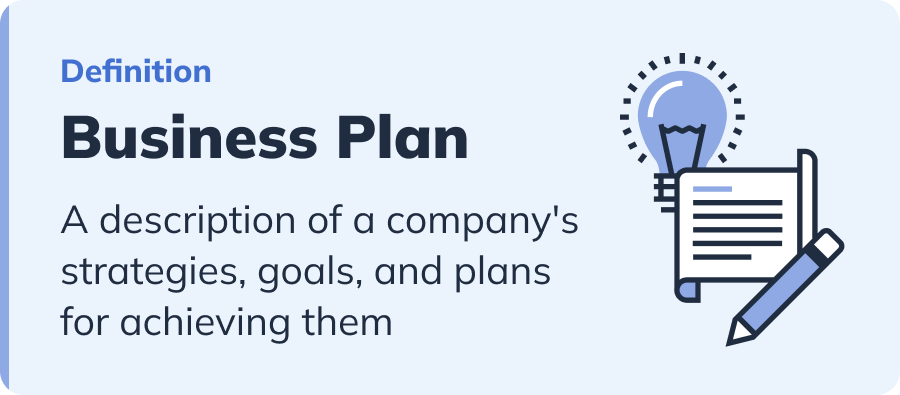Tim Berry is the founder and chairman of Palo Alto Software , a co-founder of Borland International, and a recognized expert in business planning. He has an MBA from Stanford and degrees with honors from the University of Oregon and the University of Notre Dame. Today, Tim dedicates most of his time to blogging, teaching and evangelizing for business planning.
What is a Business Plan? Definition and Resources

9 min. read
Updated April 19, 2024
If you’ve ever jotted down a business idea on a napkin with a few tasks you need to accomplish, you’ve written a business plan — or at least the very basic components of one.
The origin of formal business plans is murky. But they certainly go back centuries. And when you consider that 20% of new businesses fail in year 1, and half fail within 5 years, the importance of thorough planning and research should be clear.
But just what is a business plan? And what’s required to move from a series of ideas to a formal plan? Here we’ll answer that question and explain why you need one to be a successful business owner.
What is a business plan?

A business plan lays out a strategic roadmap for any new or growing business.
Any entrepreneur with a great idea for a business needs to conduct market research, analyze their competitors, validate their idea by talking to potential customers, and define their unique value proposition.
The business plan captures that opportunity you see for your company: it describes your product or service and business model, and the target market you’ll serve.
It also includes details on how you’ll execute your plan: how you’ll price and market your solution and your financial projections.
Reasons for writing a business plan
If you’re asking yourself, ‘Do I really need to write a business plan?’ consider this fact:
Companies that commit to planning grow 30% faster than those that don’t.
Creating a business plan is crucial for businesses of any size or stage.
If you plan to raise funds for your business through a traditional bank loan or SBA loan, none of them will want to move forward without seeing your business plan. Venture capital firms may or may not ask for one, but you’ll still need to do thorough planning to create a pitch that makes them want to invest.
But it’s more than just a means of getting your business funded. The plan is also your roadmap to identify and address potential risks.
It’s not a one-time document. Your business plan is a living guide to ensure your business stays on course.
Related: 14 of the top reasons why you need a business plan
Brought to you by
Create a professional business plan
Using AI and step-by-step instructions
Create Your PlanSecure funding
Validate ideas
Build a strategy
What research shows about business plans
Numerous studies have established that planning improves business performance:
- 71% of fast-growing companies have business plans that include budgets, sales goals, and marketing and sales strategies.
- Companies that clearly define their value proposition are more successful than those that can’t.
- Companies or startups with a business plan are more likely to get funding than those without one.
- Starting the business planning process before investing in marketing reduces the likelihood of business failure.
The planning process significantly impacts business growth for existing companies and startups alike.
Read More: Research-backed reasons why writing a business plan matters
When should you write a business plan?
No two business plans are alike.
Yet there are similar questions for anyone considering writing a plan to answer. One basic but important question is when to start writing it.
A Harvard Business Review study found that the ideal time to write a business plan is between 6 and 12 months after deciding to start a business.
But the reality can be more nuanced – it depends on the stage a business is in, or the type of business plan being written.
Ideal times to write a business plan include:
- When you have an idea for a business
- When you’re starting a business
- When you’re preparing to buy (or sell)
- When you’re trying to get funding
- When business conditions change
- When you’re growing or scaling your business
Read More: The best times to write or update your business plan
How often should you update your business plan?
As is often the case, how often a business plan should be updated depends on your circumstances.
A business plan isn’t a homework assignment to complete and forget about. At the same time, no one wants to get so bogged down in the details that they lose sight of day-to-day goals.
But it should cover new opportunities and threats that a business owner surfaces, and incorporate feedback they get from customers. So it can’t be a static document.
Related Reading: 5 fundamental principles of business planning
For an entrepreneur at the ideation stage, writing and checking back on their business plan will help them determine if they can turn that idea into a profitable business.
And for owners of up-and-running businesses, updating the plan (or rewriting it) will help them respond to market shifts they wouldn’t be prepared for otherwise.
It also lets them compare their forecasts and budgets to actual financial results. This invaluable process surfaces where a business might be out-performing expectations and where weak performance may require a prompt strategy change.
The planning process is what uncovers those insights.
Related Reading: 10 prompts to help you write a business plan with AI
How long should your business plan be?
Thinking about a business plan strictly in terms of page length can risk overlooking more important factors, like the level of detail or clarity in the plan.
Not all of the plan consists of writing – there are also financial tables, graphs, and product illustrations to include.
But there are a few general rules to consider about a plan’s length:
- Your business plan shouldn’t take more than 15 minutes to skim.
- Business plans for internal use (not for a bank loan or outside investment) can be as short as 5 to 10 pages.
A good practice is to write your business plan to match the expectations of your audience.
If you’re walking into a bank looking for a loan, your plan should match the formal, professional style that a loan officer would expect. But if you’re writing it for stakeholders on your own team—shorter and less formal (even just a few pages) could be the better way to go.
The length of your plan may also depend on the stage your business is in.
For instance, a startup plan won’t have nearly as much financial information to include as a plan written for an established company will.
Read More: How long should your business plan be?
What information is included in a business plan?
The contents of a plan business plan will vary depending on the industry the business is in.
After all, someone opening a new restaurant will have different customers, inventory needs, and marketing tactics to consider than someone bringing a new medical device to the market.
But there are some common elements that most business plans include:
- Executive summary: An overview of the business operation, strategy, and goals. The executive summary should be written last, despite being the first thing anyone will read.
- Products and services: A description of the solution that a business is bringing to the market, emphasizing how it solves the problem customers are facing.
- Market analysis: An examination of the demographic and psychographic attributes of likely customers, resulting in the profile of an ideal customer for the business.
- Competitive analysis: Documenting the competitors a business will face in the market, and their strengths and weaknesses relative to those competitors.
- Marketing and sales plan: Summarizing a business’s tactics to position their product or service favorably in the market, attract customers, and generate revenue.
- Operational plan: Detailing the requirements to run the business day-to-day, including staffing, equipment, inventory, and facility needs.
- Organization and management structure: A listing of the departments and position breakdown of the business, as well as descriptions of the backgrounds and qualifications of the leadership team.
- Key milestones: Laying out the key dates that a business is projected to reach certain milestones, such as revenue, break-even, or customer acquisition goals.
- Financial plan: Balance sheets, cash flow forecast, and sales and expense forecasts with forward-looking financial projections, listing assumptions and potential risks that could affect the accuracy of the plan.
- Appendix: All of the supporting information that doesn’t fit into specific sections of the business plan, such as data and charts.
Read More: Use this business plan outline to organize your plan
Different types of business plans
A business plan isn’t a one-size-fits-all document. There are numerous ways to create an effective business plan that fits entrepreneurs’ or established business owners’ needs.
Here are a few of the most common types of business plans for small businesses:
- One-page plan: Outlining all of the most important information about a business into an adaptable one-page plan.
- Growth plan: An ongoing business management plan that ensures business tactics and strategies are aligned as a business scales up.
- Internal plan: A shorter version of a full business plan to be shared with internal stakeholders – ideal for established companies considering strategic shifts.
Business plan vs. operational plan vs. strategic plan
- What questions are you trying to answer?
- Are you trying to lay out a plan for the actual running of your business?
- Is your focus on how you will meet short or long-term goals?
Since your objective will ultimately inform your plan, you need to know what you’re trying to accomplish before you start writing.
While a business plan provides the foundation for a business, other types of plans support this guiding document.
An operational plan sets short-term goals for the business by laying out where it plans to focus energy and investments and when it plans to hit key milestones.
Then there is the strategic plan, which examines longer-range opportunities for the business, and how to meet those larger goals over time.
Read More: How to use a business plan for strategic development and operations
Business plan vs. business model
If a business plan describes the tactics an entrepreneur will use to succeed in the market, then the business model represents how they will make money.
The difference may seem subtle, but it’s important.
Think of a business plan as the roadmap for how to exploit market opportunities and reach a state of sustainable growth. By contrast, the business model lays out how a business will operate and what it will look like once it has reached that growth phase.
Learn More: The differences between a business model and business plan
Moving from idea to business plan
Now that you understand what a business plan is, the next step is to start writing your business plan.
The best way to start is by reviewing examples and downloading a business plan template. These resources will provide you with guidance and inspiration to help you write a plan.
We recommend starting with a simple one-page plan; it streamlines the planning process and helps you organize your ideas. However, if one page doesn’t fit your needs, there are plenty of other great templates available that will put you well on your way to writing a useful business plan.







